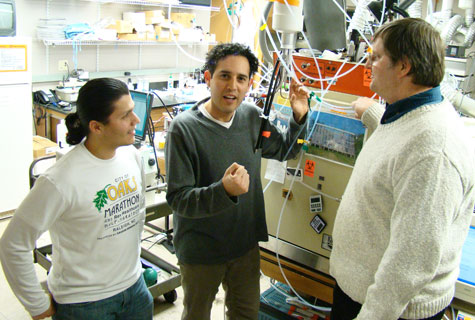‘Gillings Sampler’ offers efficient, portable way to study impact of pollution on lung tissue
July 23, 2014
A team of researchers at UNC Gillings School of Global Public Health has designed and developed a system that uses electrostatics to study the toxicity of airborne pollutants.
William Vizuete PhD, associate professor in the Gillings School’s Department of Environmental Sciences and Engineering, and his colleagues developed the Gillings Sampler, the workings of which are detailed in “The Gillings Sampler — An electrostatic air sampler as an alternative method for aerosol in vitro exposure studies,” published online July 7 in the journal Chemico-Biological Interactions.

Dr. Will Vizuete (center) describes work being done in his lab. With him are study co-authors Drs. Jose Zavala (left) and Kenneth Sexton.
The new technology ensures basic analysis conditions such as direct pollutant-cell interaction, tissue culture environments and uniform exposure to pollutants and will allow researchers to test more efficiently and to better share results of exposure to environmental pollutants. The results of the paper demonstrate that this instrument is ready for the community to use to more accurately study the toxicity and health risk of exposures to particles in the air.
Accepted methods of analyzing airborne pollutants lack a completely reliable standard for measuring. Different aerosol exposure systems use a variety of mechanisms in testing environments — diffusion, sedimentation, cloud settling and electrostatic precipitation. While these methods all work to a certain extent, none is standardized.
That lack of standardized testing and the limited availability of an in-house system that could be shared with other research groups make it difficult to fully compare research results. Not all exposure systems use the same efficiency testing method. Replicating the methods used for these systems can be uncertain, as detailed protocols might not always be described fully or the pollutant source, such as combustion sources, makes it difficult to reproduce.
For these reasons, attempting to compare the systems based on their toxicological results can be highly problematic. In the process of testing the Gillings Sampler, Vizuete and his team created a new technology to provide a control method reproducible by any research group to help adequately compare the various exposure systems that have been developed.
Vizuete and his colleagues, in collaboration with the Gillings School’s Environmental Sciences and Engineering Design Center, developed and manufactured a prototype of the portable aerosol sampler.
The Gillings Sampler was manufactured and assembled using commercially available components, such as power supplies, heaters and controllers, and using electrostatic precipitation as its principle of operation. The sampler’s temperature and humidity regulation system introduces a portability feature that allows for potential usage in a wide range of settings.
Further testing and optimization is still required to produce a “field-deployable” and “commercially ready” in vitro system. The Gillings Sampler, however, is a stepping-stone in the development of cost-effective in vitro technology that can be made accessible to researchers in the near future.
The work was supported in part by grants from the National Institute of Environmental Health Sciences and the Gillings Innovation Laboratory Program for Research and Innovations Solutions.
Collaborating with Vizuete on the project were Kenneth G. Sexton, PhD, research assistant professor in the Department of Environmental Sciences and Engineering (ESE); Glenn W. Walters, PhD, director of the ESE Design Center; Jose Zavala, PhD, ESE research assistant; Kim Lichtveld, PhD, postdoctoral fellow with the U.S. Environmental Protection Agency (EPA); Seth Ebersviller, PhD, postdoctoral researcher with the EPA; Johnny L. Carson PhD, professor in the UNC School of Medicine’s Department of Pediatrics; Ilona Jaspers, PhD, associate professor in pediatrics and director of the UNC School of Medicine’s Curriculum in Toxicology; and Harvey E. Jeffries, PhD, ESE professor emeritus.
Vizuete, Sexton and Walters own equity in BioDeptronix LLC, a privately held company that holds an exclusive license for this invention with UNC. Vizuete, Sexton and Walters are co-founders and board members of the company.
Gillings School of Global Public Health contact: David Pesci, director of communications, (919) 962-2600 or dpesci@unc.edu.
